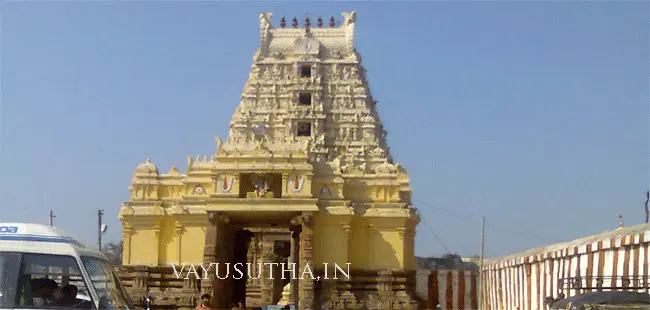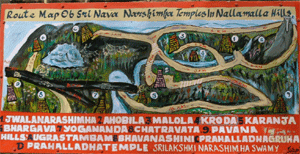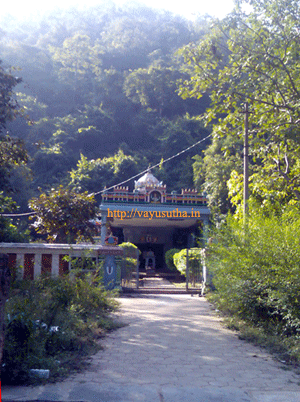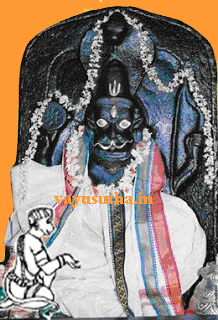
Ahobilam
Ahobilam is located in the Kurnool district of Andhra Pradesh in the hills known as Garudadri of the Eastern Ghats and is about 400 KM northwest of Chennai.
 The place is famous for the nine shrines for Lord Narasimha located within a radius
of five kilometers. Ahobilam is known in two parts. The lower plain of the hill is
known as Diguvu Ahobilam i.e. Lower Ahobilam where the temple of Sri Prahalada
Varadhan [another name for Lord Narasimha] is located. The second part is known as
Eguvu Ahobilam or Upper Ahobilam where the nine shrines of Lord Narasimha are
located. While it may be easy to reach the lower Ahobilam by road, the upper
Ahobilam is in the Garudadri mountain range and the difficult terrain is to be
covered only by trekking.
The place is famous for the nine shrines for Lord Narasimha located within a radius
of five kilometers. Ahobilam is known in two parts. The lower plain of the hill is
known as Diguvu Ahobilam i.e. Lower Ahobilam where the temple of Sri Prahalada
Varadhan [another name for Lord Narasimha] is located. The second part is known as
Eguvu Ahobilam or Upper Ahobilam where the nine shrines of Lord Narasimha are
located. While it may be easy to reach the lower Ahobilam by road, the upper
Ahobilam is in the Garudadri mountain range and the difficult terrain is to be
covered only by trekking.
Significance of Ahobilam
Ahobilam is a part of the Eastern Ghats. It is believed that the Eastern Ghats form a picturesque divinity of the great serpent Sri Adisesha with its hood at Tirumala, its middle at Ahobilam, and its tail-end portion at Srisailam. Therefore all these three places are considered the most sacred and in Tirumala we have the abode of Sri Venkateswara, at Ahobilam that of Lord Nava Narasimha, and at Srisailam Lord Maligarjuna.
Ahobilam: The name
Devas after the darshan of Lord Vishnu in the fierce form of Lord Narasimha when slaying the demon king Hiranyakasipu were wonder-struck and exclaimed “Ho! What strength” – Ahobalam in Sanskrit [Aho is an exclamation Balam means strength]. Later it became Ahobilam. A variant to this is that Sri Garuda undertook the penance to see Lord Vishnu as Lord Narasimha in a cave and had darshan of the Lord; hence the entire place came to be known as Ahobilam. Aho is an exclamation word. Bhilam (bhilam means cave). It is equivalent to 'oh the mighty cave' and thus aho-bhilam of lord Narasimha Swamy.
Sri Anjaneya had penanced here to have darshan of Sri Narasimha as he had not seen the Lord in this form. Since Sri Anjaneya would like to see Sri Rama in every form of Lord Vishnu, Lord Sri Narasimha gave darshan to Sri Anjaneya as Sri Narasimha as well as Sri Rama in this unique form here in this kshetra.
Nava Narasimha kshetras of Ahobilam
There are nine kshetras in Ahobilam where Lord Sri Narasimha gives darshan to the devotees in a different form. The Nine Narasimhasthalas are:- 1. Jwala Narasimha 2. Ahobila Narasimha 3. Malola Narasimha 4. Kroda Narasimha 5. Karanja Narasimha 6. Bhargava Narasimha 7. Yogananda Narasimha 8. Kshatravata Narasimha and 9. Pavana or holy Narasimha.
Sri Karanja Narasimha kshetra
 Sri Karanja Narasimha Kshetra is seen as the fifth kshetra and is unique in many
ways. As you travel from Lower Ahobilam towards Upper Ahobilam you will come to the
place where Sri Kaaranja Narasimha is. The shrine is situated at a distance of one
kilometer from the Upper Ahobilam, six kilometers from lower Abhobilam, and one
furlong from the road leading to Lower Ahobilam. The place gets its name Kaaranja’, as it is in the midst of the forest of Pungai (Honge) trees ‘kaaranja’ in Sanskrit
is 'pungu' in Telugu and 'pungai' in Tamil. The image of the deity is installed in
the forest which is full of this tree, called 'Kaaranja Vruksham'. Sri Narasimha of
this place thus came to be known as one who resides in the forest of Kaaranja tree –
Sri Karanja Narasimha. The temple is set on a picturesque backdrop with Garudathri
Mountain and is very pleasing to the eyes. It is located on the banks of the
Papa-nashini River which presents an added beauty to the atmosphere and calms one’s
mind.
Sri Karanja Narasimha Kshetra is seen as the fifth kshetra and is unique in many
ways. As you travel from Lower Ahobilam towards Upper Ahobilam you will come to the
place where Sri Kaaranja Narasimha is. The shrine is situated at a distance of one
kilometer from the Upper Ahobilam, six kilometers from lower Abhobilam, and one
furlong from the road leading to Lower Ahobilam. The place gets its name Kaaranja’, as it is in the midst of the forest of Pungai (Honge) trees ‘kaaranja’ in Sanskrit
is 'pungu' in Telugu and 'pungai' in Tamil. The image of the deity is installed in
the forest which is full of this tree, called 'Kaaranja Vruksham'. Sri Narasimha of
this place thus came to be known as one who resides in the forest of Kaaranja tree –
Sri Karanja Narasimha. The temple is set on a picturesque backdrop with Garudathri
Mountain and is very pleasing to the eyes. It is located on the banks of the
Papa-nashini River which presents an added beauty to the atmosphere and calms one’s
mind.
Sri Karanja Narasimha
Mythologically Karanja Sri Narasimha was worshipped by Sri Kapila Rishi to ward off the curse given by Sri Durvasa Rishi. Sri Narasimha has taken a unique form in this kshetra. The Lord is in Padmasana under a tree called Punga (Honge) tree with ‘chadur bhuja’ [four armed]. The Lord is seen with a bow and arrows [which are normally seen with Sri Rama] in His left upper hand, the right upper hand holds ‘Sri Sudershanam’, lower hands are showing ‘abhaya’ mudra. Lord has ‘tri_nethra’ and Sri Adi Shesha with one head covering the Lord as ‘Shatri’. It is interesting to note that the Lord had taken this form in this Kshetra to appear as Sri Rama, to give darshan to Sri Anjaneya.
Sri Karanja Anjaneya sannidhi
 The sannidhi of the Lord Sri Narashima is facing the Bhavanashini River with
Garudathri Mountain in the background. Sri Garudalwar is facing the Lord. After
offering prayers to Sri Garudalwar one can see another
sannidhi on the left side.
This sannidhi houses Sri Anjaneya. Sri Anjaneya of this
kshetra is known by the name
Karanja Anjaneya. Sri Anjaneya had penanced here to have the
darshan of Sri
Narasimha as he had not seen the Lord in this form. Since Sri Anjaneya would like to
see Sri Rama in every form of Lord Vishnu, Lord Sri Narasimha gave
darshan to Sri
Anjaneya as Sri Narasimha as well as Sri Rama in this unique form here in this
kshetra.
The sannidhi of the Lord Sri Narashima is facing the Bhavanashini River with
Garudathri Mountain in the background. Sri Garudalwar is facing the Lord. After
offering prayers to Sri Garudalwar one can see another
sannidhi on the left side.
This sannidhi houses Sri Anjaneya. Sri Anjaneya of this
kshetra is known by the name
Karanja Anjaneya. Sri Anjaneya had penanced here to have the
darshan of Sri
Narasimha as he had not seen the Lord in this form. Since Sri Anjaneya would like to
see Sri Rama in every form of Lord Vishnu, Lord Sri Narasimha gave
darshan to Sri
Anjaneya as Sri Narasimha as well as Sri Rama in this unique form here in this
kshetra.
Sri Karanja Anjaneya
Sri Anjaneya of this kshetra is seen turned facing Lord Karanji Sri Narasimha with folded hands. He has a tuft and his long hair is tied up very neatly. On his two sides one could see the Chanku [conch] and the Chakra [wheel -Sudershana]. This imprint had come to Sri Anjaneya when Sri Rama had embraced him. His eyes are glowing with brilliance at the sight of the unique Sri Rama in Sri Narashima. His lotus feet are wearing Thandai and are seen walking towards Karanja Sri Narasimha.
Location of the temple: "Karanja Sri Narasimha Temple, Ahobilam, Andhra"
Experience
Have darshan of Karanja Sri Anjaneya who had penanced to give us the unique form of Karanja Sri Narasimha. He can bestow all unique blessings on us.
SRI HANUMAN THINKS DIFFERENTLY, THINKS FAST
THINKS AHEAD AND ACTS FOR SURE
Ed [December 2012]
Revised Feb.2019
Updates: [Jan 2025]
